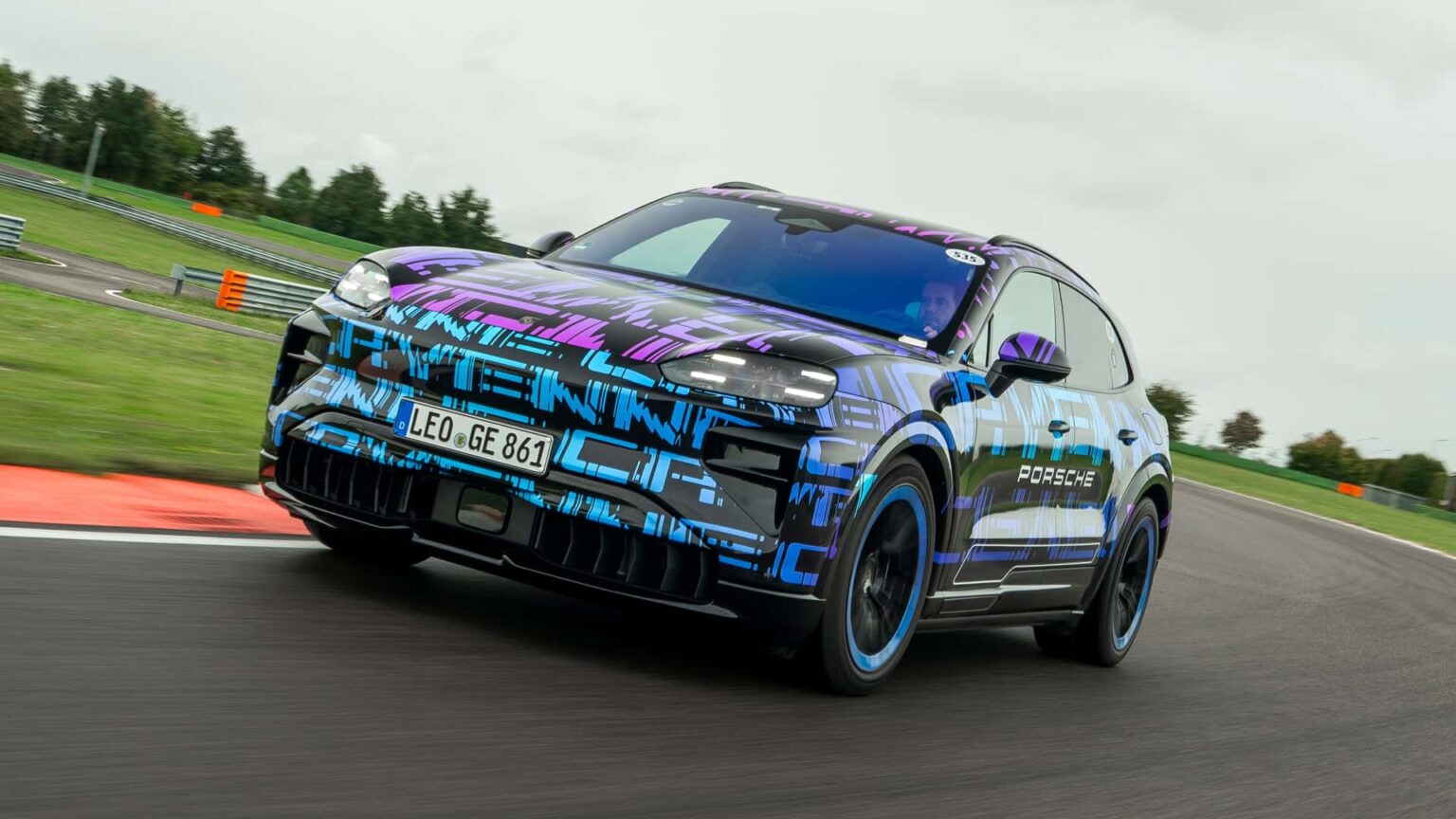Porsche is pulling back on its electric-car ambitions, realizing the hard way that demand for EVs isn’t what it once thought. But that doesn’t mean that Porsche is half-assing, either.
The upcoming Cayenne Electric will have well over 1,000 horsepower in Turbo form, and it represents a huge step beyond Porsche’s previous EV efforts. We went to Porsche’s factory in Leipzig, Germany, to learn all about this new SUV.
This is the fourth-generation Cayenne, the E4 as Porsche calls it, but it will live alongside the gas-powered third-gen for years to come. It’s the second Porsche model based on the VW Group’s Premium Platform Electric (PPE) architecture after the Macan, but this is not simply a bigger Macan Electric.
Porsche fitted the Cayenne with an entirely new battery design. It also comes with an oil-cooled rear motor for the Turbo, a reworked infotainment system, and the option of its Porsche Active Ride active-suspension system.
Photo by: Porsche
The new Cayenne follows the Porsche EV development path of increasing performance while also making it a better electric car. Porsche says the Turbo will be its most powerful production car yet, and given the Taycan Turbo GT has 1,019 hp, expect more than that. This big SUV sprints from 0-62 miles per hour in under 3.0 seconds and from 0-124 mph in under eight seconds. Total torque output is a crushing 1,106 pound-feet.
But, the Cayenne Turbo is also capable of up to 600 kilowatts of regenerative braking; it recharges at 400 kW (or about 16 minutes from 10 to 80 percent); has a 113.0-kilowatt-hour battery that’s more energy dense than the Taycan’s; and promises 373 miles of range on the (admittedly optimistic) European test cycle.
Talking with engineers, you get the impression that they looked for every way to boost efficiency. The big thing is the battery pack, which ditches a traditional frame and instead bolts its six modules of 32 pouch cells each to the vehicle frame, a move that saves weight and increases energy density, as there’s no separate frame for the battery. There are small measures too, like moving the cooling fans in front of, rather than behind the radiators.

Photo by: Porsche
The rear motor in the Turbo is particularly interesting, too. Porsche designed it in-house, and it uses direct oil-cooling on the copper windings to allow for higher sustained performance and greater regen capability. The design is inspired by that of the Cayman GT4 E-Performance concept car, and it’s not dissimilar to what Lucid is doing with its motors. Also, as previously announced, the Cayenne Electric will be the first production EV capable of wireless inductive charging, though this will be an optional feature.
Chassis-wise, it’s not too dissimilar to the Macan, with a four-link front suspension and a multi-link rear axle. Like its platform mate, but unlike the Audi models that also use PPE, the rear motor is mounted “backwards” to ensure a slightly rearward weight bias of 52 percent. Also like the Macan, the Cayenne Electric uses single-speed transmissions, as the motor’s spread of performance and efficiency doesn’t require the two-speed rear gearbox Porsche uses on the Taycan.
Porsche Active Ride is adapted from the Panamera and Taycan, and it works basically the same way. Each damper is connected to an electrohydraulic motor-pump unit that regulates the pressure of the damper’s hydraulic fluid. This allows the system to put force into the body regardless of road input, allowing for total body control.
Compared with the Taycan and Panamera, the Cayenne gets larger-tube dampers for off-road performance, and some software tweaks as well. As standard, the Cayenne Electric gets semi-active, height-adjustable air suspension with Porsche Active Suspension Management (PASM) adaptive dampers.

Photo by: Porsche
Inside, Porsche is also taking a step forward from the Macan. It’s all familiar, of course, but the highlight is the new, curved center display, which swoops down toward a palm rest. Porsche, thankfully, maintained lots of physical controls, too, and a quick sit in a prototype reveals the user interface is typically Porsche easy.
We’re still a couple of months out from the full debut of the Cayenne Electric, so we don’t have full specs or pricing yet. But we do have passenger-seat impressions from a ride around the Porsche Experience Center Leipzig track. Unsurprisingly, the Cayenne Turbo Electric is brutally quick, accelerating relentlessly well beyond triple-digit speeds. But with Active Ride, the body control and grip are astounding. And, as 2/3rds of the power comes from the rear, you can actually slide the thing around, too.
Porsche may be in a tough situation now with EVs, but there’s no question that it’s pushing forward hard with engineering. Life for the Lucid Gravity may get a bit harder.

141
Read the full article here



